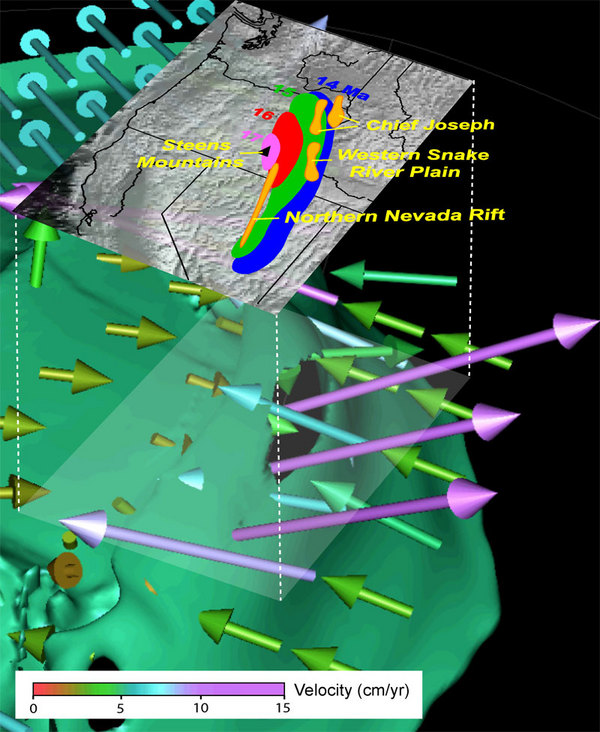Ancient Yellowstone Eruptions Not from Supervolcano, Study Says


Ancient giant eruptions in the Pacific Northwest may actually have been caused by the tearing of a titanic slab of rock and not the supervolcano underlying Yellowstone National Park, scientists now suggest.
Supervolcanoes are capable of eruptions dwarfing anything ever recorded by humanity. There are roughly a dozen supervolcanoes on Earth today, one of which sits beneath Yellowstone National Park.
Volcanism at Yellowstone is thought to have started with the Steens-Columbia River flood basalts. A flood basalt is the result of a large volcanic eruption that covers vast areas with lava, and the Steens–Columbia River flood basalts erupted more than 55,000 cubic miles (230,000 cubic kilometers) of molten rock over approximately 2 million years, spewing out more than 1 million times the notorious Mount St. Helens eruption in 1980.
Flood basalts are thought to typically occur when the head of a giant mushroom-shaped upwelling of hot rock rising from near the Earth's core, known as a mantle plume, reaches the surface. Now researchers suggest a new way for these massive eruptions to form — a breach in a massive slab of the Earth's crust.
Ripping rock
Scientists generated computer models of how the complicated structure of the Earth's mantle layer under the western United States evolved over the past 40 million years. They based their work on data from the USArray, a mobile seismic network of 400 sensor stations traveling across the United States.
The researchers suggest that about 17 million years ago, a giant chunk of rock known as the Farallon slab that was diving underneath the western United States began ripping apart. This led to massive outpourings of magma, the pattern and timing of which appear consistent with the Steens–Columbia River flood basalts.
Get the world’s most fascinating discoveries delivered straight to your inbox.
"When the slab is first opened, there's a little tear, but because of the high pressure underneath, the material is able to force its way through the hole," said researcher Dave Stegman, a geophysicist at the University of California, San Diego. "It's like in the movies when a window breaks in an airplane that is at high altitude — since the cabin is at higher pressure, everything gets sucked out the window."
Volcanoes are most often seen at the boundaries of tectonic plates. These new findings shed light on a way — in addition to mantle plumes — that volcanoes can emerge within tectonic plates, the researchers said. [10 Wild Volcano Facts]
"Only with a break of this scale inside the down-going slab can we reach the present-day geometry of mantle we see in the area," said researcher Lijun Liu, a geophysicist also at UC San Diego. "Geochemical evidence from the Columbia River lavas can also be explained by our model."
Mantle plumes, subducted slabs
Intriguingly, the supervolcano at Yellowstone seems to be due to a mantle plume under the area, but the researchers do not think it was involved with the Steens–Columbia River flood basalts. "There are 40 to 50 active mantle plumes in the Earth right now, so just because one is close doesn't mean that it was behind these flood basalts," Stegman told OurAmazingPlanet. Still, he added, "we are now incorporating the Yellowstone plume into our modeling so we can learn a bit more about this region."
Future research can also investigate the effects of slabs of rock diving underneath other tectonic plates.
"There are subducted tectonic plates, or slabs, underneath South America we'd want to understand better, and slabs underneath south Asia where there was a collision between India and Eurasia, and slabs underneath the Pacific Northwest, such as the Aleutians and central Alaska," Stegman said.
The scientists detailed their findings in the Feb. 16 issue of the journal Nature.
This story was provided by OurAmazingPlanet, a sister site to LiveScience.



